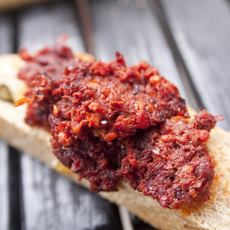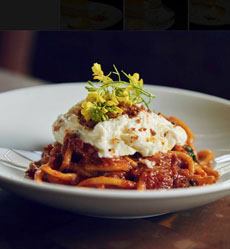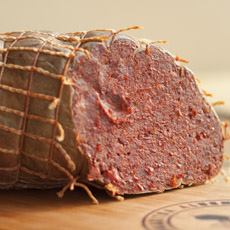TIP OF THE DAY: ‘Nduja, Spreadable Hot Salami
|
|
‘Nduja (pronounced in-doo-ya), is a spicy—some say fiery—pork spread from the Calabria region of Italy. Think of it as spreadable hot soppressata or pepperoni with the texture of pâté-like texture. It is typically made with pork shoulder, belly, and jowl, as well as tripe, roasted chiles, and spices. It is loosely based on the French andouille sausage, developed in the 13th century by the Angevins, from the area of Anjou in western France. It is typically made with parts of the pig such as the shoulder, belly, and jowl, as well as roasted hot peppers and a mixture of spices. Nduja has a characteristic fiery taste. It is a Calabrian variation of salami, loosely based on the French andouille introduced in the 13th century by the Angevins. Finally, North American producers of Italian-style salume like La Quercia began to make it. ‘Nduja Artisans in Chicago, which sells online, is the latest American producer we know of. Over the last couple of years, creative chefs discovered it and found ways to use it. While ‘nduja still has limited distribution nationwide, you can find it in Italian specialty stores including Eataly, in some Whole Foods Markets, and of course, online. You can use ‘nduja in any meal of the day. We hope it turns into a foodie trend sooner rather than later. > September 7th is National Salami Day. > January 16th is International Hot and Spicy Food Day. Most historians believe that ‘nduja was created as a poor man’s version of andouille sausage, which arrived in the area at the time Napoleon conquered Naples in 1806. The folks in the town of Spilinga, in western Calabria (the toe of the boot of southern Italy), made a version with pork fat, ground lung, kidneys, scraps from the head, other trimmings, and some skin, and spiced it with fiery local chilies. The ground meat was stuffed into a casing (pig intestine) and then smoked, yielding a very robust-flavored salume. Some ’nduja is aged, for even more flavor. What About The Name? It looks and sounds unusual (when we first saw it in print, we thought it was an African food). It’s actually derived from the French word, andouille (on-DWEE), which means sausage. ‘Nduja has traditionally been served with slices of bread or hearty cheeses. It can spice up just about anything. Because of its high-fat content, it melts into sauces and pizzas. Consider it: |
|
|
Wrapped in plastic, ‘nduja lasts for months in the fridge. In our home, it need only last for a week. Outside of Calabria, ‘nduja is perhaps the best-known food. Calabrians are so proud of it that they’ve been holding an annual ‘Nduja Festival since 1975. It takes place in Spilinga, on August 8th. Attendees can taste ‘nduja in numerous ways, surrounded by folk music and traditional entertainments around Monte Poro (Spilinga). If you decide that ‘nduja is your new favorite food, you may want to book a trip! *There are different regional styles of soppressata. Here are the different varieties. †Salume has been Americanized to salami, the term for spiced ground meat, usually pork, stuffed into a casing and cured. CHECK OUT WHAT’S HAPPENING ON OUR HOME PAGE, THENIBBLE.COM. |
||







